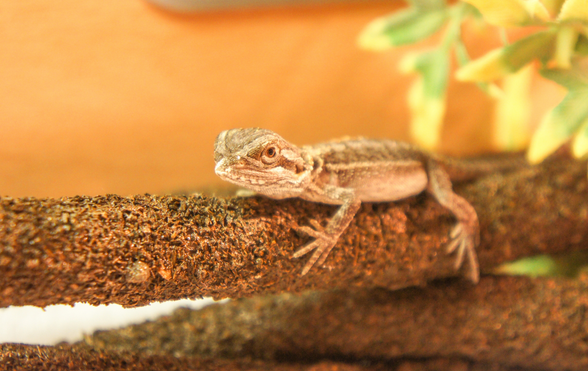It’s advisable to keep a new bearded dragon (or any lizard) away from other pet reptiles for the first few months, to monitor for health conditions that could be contagious.
Don’t forget your lizard insurance! Get a quote for £1,000 of vet fees, death and theft cover. Vet fee cover only also available | We’ve been insuring exotic pets since 1996 | Check out our customer reviews on Feefo.
Pete Hawkins talks through his quarantine enclosure for Willow his bearded dragon, in our video below.
Skip to article content: Why keep separate? | The first month | The second month | Faecal and blood tests | Common issues | The third month
Why keep separate?
When bringing home a new bearded dragon, you should keep it in a separate enclosure to your other lizards.
In addition, a bare setup is vital with minimal décor in the form of a slate to bask on, worm, salad and water bowl, logs to rest on, a hide and optimal heat and UVB. But nothing else.
I also prefer to keep a new dragon in a separate room away from any other species.
This is to prevent any illness, parasites, ailments such as mites, Atadenovirus (Adenovirus), or similar spreading to another enclosure and its inhabitants.
So having the enclosure away from other species is best practice here.
If you can’t do this due to space restrictions, try and keep the quarantine enclosure away from other enclosures as best you can.
Of course, practicing good hygiene yourself, washing your hands and items used such as food and water bowls, equipment etc, and daily cleaning of the enclosure is absolutely essential.
Quarantine is all about keeping new animals away from your collection and observing behaviour.
I quarantine for three months, during which time I observe for visual issues, like mites, and neurological issues. For example: can the dragon hunt and walk correctly? I also make sure the new dragon settles into a good feeding regime.

The first month with your bearded dragon
This is mostly a settling period, and observing for the above mentioned.
But also making sure the new reptile is registered with an exotic vet. You can find your nearest one on ExoticDirect’s Find a vet page. It’s worth obtaining insurance with ExoticDirect, as vet treatment can be very expensive.
During that first month if there are any issues, then treat accordingly via your vet.
The second month with your bearded dragon
The dragon should be settled and eating well by now. At this point I’ll get faecal tests done to check for pinworms and coccidia, a faecal swab test for Atadenovirus (Adenovirus) and blood tests.
Blood tests will ensure everything internally is working as it should.
I should also emphasise the importance of a faecal swab test for Atadenovirus (Adenovirus). This virus can cause lethargy, loss of appetite and weight loss as well as neurological problems. It can spread to other lizards and destroy entire collections.
It’s best to find out about any conditions and provide any treatment, before you add your bearded dragon to a room where other reptiles are present.
I also recommended your dragon remains separate if it tests positive for Atadenovirus (Adenovirus).
Where to get faecal and blood tests done for bearded dragons
Your vet should be able to provide the relevant tests, but if not, then you can go through PALs, (Pinmoore Animal Lab).
Both will test the dragons waste, and this will identify any internal parasites. The blood tests will also identify issues and a PCR test will check for Atadenovirus (Adenovirus) DNA in your dragons faeces.
If you go through PALs, you can take the results to your vet, and they can use the information and treat if needed.
Common issues
Most common issues are pinworms and coccidia with both being relatively easy to treat. However coccidia is more of a pain to clear.
Both are spread easily, hence why strict hygiene is essential to reduce reinfection.
This is another reason for a plain/bare setup while in quarantine – to enable easier cleaning.
An F10SC or HabiStat bactericidal used daily, on décor, water and food bowls will aid the cleaning process, killing pinworms, and helping to kill Coccidia.
However this won’t kill Coccidia alone. Steam is a very effective way to do this, and I would recommend getting a handheld steam cleaner.
Contact time is essential for all forms of cleaning. When using bactericidal you should spray and leave to dry, then spray again.
And when using a steam cleaner, do a double and triple pass.
Third month
By this time treatment should be finished, and it’s now a case of making sure the dragon is over treatment and eating again properly.
You can have a final faecal test done to confirm all is clear and healthy before moving the dragon into your reptile room.
Don’t forget your lizard insurance! Get a quote for £1,000 of vet fees, death and theft cover. Vet fee cover only also available | We’ve been insuring exotic pets since 1996 | Check out our customer reviews on Feefo.

